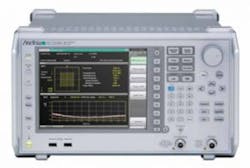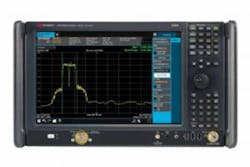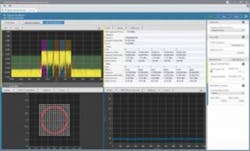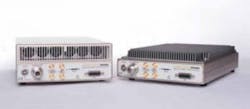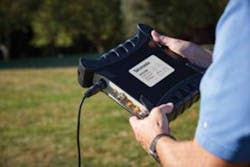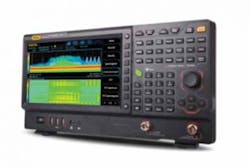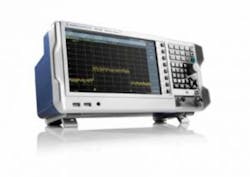Choose the optimum form factor for your analysis chores
Signal and spectrum analyzers come in a variety of form factors and architectures and offer applicability from the R&D lab to the field. Anritsu, for example, offers instruments with wide analysis bandwidths and high-level accuracy for R&D, instruments that can make measurements at high speed for production, and handheld instruments for field applications, according to Adnan Khan, senior business development manager.
Whereas Anritsu offers traditional bench and handheld analyzers, Keysight Technologies also offers PXI instruments and systems. The company’s bench, portable, and PXI versions serve a range of application needs. “The variety of configurations caters to a diverse pool of customers to fit their budget and measurement needs,” said Vandana Duff, product marketing engineer.
National Instruments also offers PXI signal-analysis instruments and in fact sees the PXI platform as the best approach for serving the test and measurement market. With the PXI platform, said Chris Davis, product marketing manager, RF, “…all PXI-based instruments are part of a modular, software-designed system that provides a user-customized set of high-quality I/O alongside subnanosecond synchronization across instruments, integrated precision triggering, and direct instrument control through native drivers. The platform-based approach also ensures that test solutions are resilient to changing test requirements and new standards as technology evolves, which helps to keep system cost down over time.”
Yet another option is the headless USB instrument. Although Tektronix offers instruments in a variety of shapes and sizes (the recently introduced 6 Series MSO oscilloscope with its large touchscreen, for example), its most recently introduced signal analyzer employs a USB architecture. And Signal Hound focuses exclusively on the USB architecture for its signal analyzers.
Companies including RIGOL and SIGLENT focus on the benchtop form factor. “Handheld designs and alternative form factors (USB and PXI) have their uses,” said Michael Rizzo, general manager, RIGOL USA. “But in most general-purpose applications, the power and ease of use associated with a traditional benchtop instrument provides the most powerful and flexible solution.”
Jason Chonko, applications marketing manager at SIGLENT Technologies NA, concurred with Rizzo on many points. “USB instrumentation can be ideal for data acquisition and product test as well as field testing where a laptop or computer can accompany the test set,” he said. “These systems are typically controlled using proprietary software and can’t be easily operated without it.”
He continued, “PXI systems…have the advantage of higher test throughput capabilities. These systems require special mainframe/racks with display, a controlling computer module, and software to operate efficiently. They are typically devoted to fully automated test stands with custom-programmed control software.”
Further, he said, handheld instruments have the advantage of portability but can incur higher purchase and maintenance costs, related, for example, to their Li-ion batteries.
With many bench instruments, he said, you can avoid boot times and log-in requirements and the possible need for programming—“Just plug in and go.”
Chonko added, “Benchtop instrumentation usually has better performance and features at lower prices than handheld or portable instrumentation. Benchtop instrumentation can also be rack mounted and used in automated-test/computer-controlled data-acquisition systems where there is enough space to accommodate the larger volume taken up by the full instrument.”
5G measurement software
Khan at Anritsu commented on recently introduced signal-analysis products from his company, including 5G measurement software compliant with the 3GPP 5G New Radio (5G NR) standard for Anritsu’s MS2850A and MS269xA Series signal analyzers. “Specifically developed for the design and manufacture of 5G NR radio equipment, the software supports analyses of both uplink and downlink signals used by the sub-6-GHz frequencies as well as mmWave bands, such as 28 GHz and 39 GHz, in the 5G NR standard,” he said. “With the software installed, engineers can analyze combinations of single and multiple component carriers up to 400-MHz bandwidth and multiple sub-carrier spacing intervals simultaneously. Fast and stable signal-analysis measurements of key parameters, such as Tx power, frequency error, and EVM, are supported by the MS2850A and MS269xA Series with the software installed. With the availability of these new software features, Anritsu is capable of catering to testing in both 3GPP FR1 and FR2.”
He added that for field applications, the Spectrum Master family of handheld spectrum analyzers has been enhanced with a new Narrowband IoT (NB-IoT) analyzer option. “This new feature allows field installation and maintenance teams to verify that NB-IoT services are deployed and are working according to specification,” he said.
Khan described the MS2850A as the only analyzer in its price range that supports 5G measurements due to its 1-GHz analysis bandwidth. “It supports high-speed transfer of large digitized data from its memory to an external PC (3 s at 1-GHz analysis bandwidth) to contribute to the efficiency of testing time,” he said. “A wider difference between DANL increase and input level at wideband signal measurement allows the MS2850A to achieve a more accurate EVM measured value compared to similar signal analyzers.” In addition, he said, “The MS2850A also offers better amplitude and phase flatness over the 1-GHz analysis bandwidth than any other analyzer in its price range.” The instrument also offers a one-button auto-range function that optimizes the complex built-in attenuator settings required for accurate EVM measurement. “At a low price point, the MS2850A offers much more advanced functionality than typically available in its class,” Khan said.
Another Anritsu signal analyzer, the MS269xA Series, supports a standard analysis bandwidth of 31.25 MHz that can be extended to 125 MHz, which Khan described as one of the widest in its class. “Using a patented calibration process, the multipoint amplitude calibration and the phase calibration result in a level accuracy of ±0.5 dB across a 6-GHz span,” he said. “No other analyzer on the market can meet that specification.” He added that the MS269xA also offers an option to add a vector signal generator (VSG), allowing engineers to have a vector signal analyzer and VSG in single unit. “The modular architecture provides the MS269xA with extreme flexibility that allows the analyzer to expand its capability as measurement requirements change,” he said.
Anritsu’s analyzers find use in R&D, in manufacturing, and in the field. “The MS269xA Series, with its high standard analysis bandwidth up to 125 MHz and level accuracy of ±5 dB across a 6-GHz span, has been developed for R&D,” Khan said. “With its level of performance at a mid-price point, the MS2850A can be used in both R&D and manufacturing environments. The MS2830A, with its ability to conduct basic measurements at high speed, is designed for production applications.”
For field spectrum analysis, Anritsu offers the Spectrum Master family, including the MS2720T. “With frequency coverage from 9 kHz to 43 GHz, the MS2720T allows field engineers and technicians to conduct spectrum monitoring, hidden-signal detection, RF and microwave signal measurements, microwave backhaul testing, or cellular signal measurements,” he said.
Analysis to 110 GHz
Duff at Keysight Technologies said her company’s most recently introduced signal analyzers are in the X-Series, including the N9040B UXA, N9041B UXA, and any other “B” model signal analyzer. She described the X-Series as “…the industry-leading performance signal analyzer, with the highest frequency in the industry, of 110 GHz.” She continued, “This model has a multitouch user interface and increased flexibility with X applications that can be purchased, as needed. In addition to this, we have migrated to Windows 10 for all X-Series analyzers.”
She elaborated on the X applications. “The X-Series measurement applications are the newest software packages that provide customer-specific applications for downloads based on their specific measurement needs—including cellular, wireless, aerospace/defense, and much more,” she said. “They are updated every three to six months.”
Keysight offers signal and spectrum analyzers in a variety of form factors, including the N9344C handheld spectrum analyzer, which operates at frequencies to 20 GHz. In addition, she said, “The FieldFox is a spectrum analyzer and network analyzer in one handheld product.” The company also offers the 10-Hz to 26.5-GHz M9290A CXA-m PXIe signal analyzer, the 6-GHz M9391A PXIe vector signal analyzer, and the 50-GHz M9393A PXIe performance vector signal analyzer. “We also have a transceiver that covers the signal analyzer and signal source—the VXT vector signal transceiver M9421A,” she said.
Vector signal analyzers and transceivers
Davis at NI described his company’s signal-analysis products, including the PXIe-5668 vector signal analyzer, which has frequency coverage from 20 kHz to 26.5 GHz. “It features an average noise floor of 165 dBm/Hz and a phase noise of -129 dBc/Hz, providing the high performance needed for lab environments,” he said. “This VSA has a bandwidth of up to 765 MHz, making it ideal for analyzing radar pulses and other time-domain measurements requiring wide bandwidths. Coupled with NI’s RFmx platform, the 5668 is also an ideal instrument for making low-noise-figure measurements.”
In addition, Davis said, NI’s second-generation vector signal transceiver, the PXIe-5840, combines a 6.5-GHz RF vector signal generator, 6.5-GHz vector signal analyzer, high-performance user-programmable FPGA, and high-speed serial and parallel digital interfaces into a 2-slot PXI Express module. “With 1 GHz of instantaneous bandwidth, the latest VST is ideally suited for a wide range of applications including 802.11ac/ax device testing, mobile/Internet of Things device testing, 5G design and testing, RFIC testing, radar prototyping, and more.”
Davis elaborated on the user-programmable FPGAs, available in NI’s VSAs as well as VSTs. The FPGA, he said, enables measurement acceleration, closed-loop tests, and real-time algorithm prototyping for applications like radar target simulation, multicarrier aggregation, DPD algorithm implementations, 5G prototyping, and real-time spectrum analysis.
Davis also commented on NI software for signal-analysis and related applications. “NI-RFmx is National Instruments’ measurement-focused set of interoperable, standard-compliant measurement libraries that are organized by personality.”
Within NI-RFmx, he said, RFmx API for LabVIEW, C, and .NET is a cohesive library of measurement-focused functions that make complex RF measurements simple and ensure compliance to common cellular and wireless standards. RFmx Waveform Creator is a unified waveform-creation tool to create, download, and play back signals, with support for filter configurations and I/Q impairments. And RFmx Soft Front Panels provide an interactive measurement experience that will be familiar to traditional “box” instrument users.
The soft-front-panel function, Davis said, “…enables engineers to get the most out of their NI PXI RF VST and VSA instruments before writing a single line of code. The soft front panels support spectral analysis, NB-IoT/eMTC, and LTE-Advanced personalities.” With the most recent release of RFmx, he added, soft-front-panel monitoring and debug capabilities are available to allow users to monitor instruments that are actively being controlled with automation code, and they can pause the code to interactively debug and adjust measurement configurations.
NI’s products find use in a variety of application areas. “NI vector signal analyzers and transceivers have been widely adopted across industries including semiconductor, aerospace and defense, and more, and they support applications from design through characterization, validation, and production test,” Davis said. “The PXIe-5668 vector signal analyzer coupled with RFmx Soft Front Panels Spectral Analysis personality provides lab-quality, interactive measurements out of the box at up to 26.5 GHz and 765 MHz of instantaneous bandwidth. The very same instrument can be integrated in a PXI-based automated production test system to support high-quality measurements while reducing test time and ensuring correlation between lab and production measurements is achievable.”
USB spectrum analyzers
For its part, Tektronix on July 31 expanded its RSA500 family of rugged, battery-powered USB-based spectrum analyzers with the addition of the RSA513A and RSA518A. “These instruments now feature a 9-kHz to 18-GHz frequency range along with improved sweep speeds for addressing key applications such as EMI/EMC precompliance testing and troubleshooting, interference hunting, RF record and playback, and radar/electronic countermeasure testing in the field or lab,” said Dylan Stinson, product manager, USB RF products.
And at the beginning of the year, Tektronix’ released EMCVu as an option to its SignalVu-PC software. “It’s a new all-in-one solution for EMI/EMC precompliance testing and troubleshooting,” Stinson said. “EMCVu, featuring powerful software, an RSA spectrum analyzer, and predefined accessories, gives engineers an accurate, convenient, and cost-effective approach to determine if their product designs will pass EMC emissions compliance testing on the first try.”
He described the Tektronix real-time USB spectrum analyzers, including the affordable RSA306B, as forming the core of an EMCVu solution, adding that they offer the performance of traditional desktop instruments at a fraction of the cost. “The small size of Tektronix’ real-time USB spectrum analyzers makes it easy to perform EMI/EMC testing outside the lab environment in relatively low-noise environments, such as basements, labs, or parking garages,” he said. “Unlike other spectrum-analyzer-based EMI/EMC precompliance solutions, EMCVu offers a cost-effective, all-in-one—software, hardware, and accessories—and extremely easy-to-use solution for performing your own in-house EMC precompliance testing and troubleshooting.”
Stinson then commented on what he considers unique features of Tektronix’s analyzer products. “In regards to the RSA500 Series, many portable spectrum analyzers are well suited enough for spectral scanning but not as useful for recording and analysis since their real-time bandwidth is quite limited,” he said. “Unlike other field-portable instruments with up to 18-GHz frequency coverage, the RSA500 Series spectrum analyzers lead the industry with 40 MHz of gapless real-time bandwidth, four times more than other instruments in the category, allowing for complete, seamless capture of wideband signals in applications such as X or Ku-band radar where signal bandwidths exceed 30 MHz, saving users time when searching for interference and providing more insight during recording and analysis.”
Other recently introduced USB products include the Signal Hound SM200A 20-GHz headless RF spectrum analyzer and monitoring receiver for applications including IoT and 5G cellular. The instrument also serves military, aerospace, spectrum-management, automotive, and radar applications. Cory Allen, marketing director at Signal Hound, said the instrument is optimized for performance, flexibility, space, and cost to lower the cost of entry to high-end spectrum analysis while serving demanding production-line and spectrum-monitoring RF analysis applications. “We see customers under constant pressure to both meet the needs of rapidly evolving signal-analysis requirements while also needing to reduce test time and cost and make maximum use of available test space,” he said. “The SM200A is designed from the ground up to provide only what’s needed in today’s test environment and spectrum-monitoring deployments, with maximum performance and speed, at much reduced cost and size.”
The company also recently added VITA 49 functionality to the SM200A to increase interoperability within RF systems by providing a communications format that is hardware and supplier-independent. Typical applications for VITA 49 are spectral monitoring and scanning, signal intelligence, radar, electronic warfare, direction finding, and geolocation. Signal Hound has also added SCPI compatibility for its spectrum analyzers via its Spike software. Spike provides control of all Signal Hound spectrum analyzers using a common GUI and offers advanced signal analysis measurements and displays. Signal Hound spectrum analyzers can be programmed using three methods. The first two employ SCPI commands via Spike software either locally or remotely over the Internet. The third is via fast, direct API programming using a device-specific local API.
Benchtop analyzers
Rizzo said RIGOL has introduced two real-time spectrum analyzers in the last few months. Both deliver up to 40 MHz of real-time analysis bandwidth, a 7.45-µs 100% POI, seven visualization modes, and a frequency-mask trigger. The RSA5000 Series supports frequency ranges up to 6.5 GHz, and the RSA3000 supports frequency ranges up to 4.5 GHz.
“Both Instruments combine the power of real-time analysis with a true swept-spectrum analyzer,” Rizzo said. “This combination of traditional swept-spectrum performance and real-time analysis capabilities allows our customers to quickly capture signals of intermittent and short-duration pulses; isolate signals of interest; identify errors in frequency, power, or time; and analyze RF signals and the devices that control them.”
As for software, Rizzo said, “RIGOL delivered an updated UltraSpectrum application with the RSA3000 launch that allows for remote operation and control of your RIGOL spectrum analyzer via LAN or USB. In addition, we recently delivered the S1210 EMI precompliance package that allows the user to run prescans, run final scans, set limit lines, apply correction tables, publish test reports, and perform other essential EMI precompliance test activities.”
Chonko at SIGLENT commented on his company’s newest analyzer product—the SVA1015X, which operates from 9 kHz to 1.5 GHz and was released in late June. “This product is a real leap forward for us,” he said. “It is built off of our very popular SSA3000X Series of swept superheterodyne analyzers but incorporates a new touchscreen and integrated bridge that provides s11 and s22 scattering-parameter measurements as well as a host of software licensed upgrades. We feel that integrating these features into one instrument helps increase the value to technicians and engineers troubleshooting RF issues.”
Continued Chonko, “The entire SIGLENT product line is dedicated to driving the most value from each instrument. The base measurement specifications and performance cover a large degree of applications, and many of our products include free features that other vendors charge money for.” He added the company’s analyzer products feature EasySpectrum software that delivers remote instrument control, test sequencing, and the ability to quickly save screen images. He added, “SIGLENT has found a lot of success in all sorts of applications, but our main customer base is in broadcast/transmitter monitoring and device troubleshooting, including filter characterization and EMI/EMC precompliance testing.”
A recently introduced analyzer from Rohde & Schwarz is the R&S FPC1500, a compact instrument that combines a spectrum analyzer, a 1-port vector network analyzer, and a CW signal generator. It is suitable for education, for applications in service and repair shops, and for professional hobbyists, the company said, describing the instrument as the world’s first spectrum analyzer to include a 1-port vector network analyzer with internal VSWR bridge, an independent CW signal generator, and a tracking generator.
The base model of the R&S FPC1500 has a frequency range of 5 kHz to 1 GHz. Keycode options unlock higher frequency ranges up to 3 GHz or enable other measurement application features. Upgrades are activated immediately when the keycodes are entered, and there is no need for upgrade calibration.
For applications requiring a high sensitivity to characterize extremely weak signals, the R&S FPC1500 offers a low noise floor level of -150 dBm (typ.), which can be further extended to -165 dBm (typ.) through an optional, keycode-activated preamplifier. Its high maximum input power allows users to measure RF signals up to +30 dBm (1 W). In addition, the R&S FPC1500 offers 1-Hz RBW and 10.1” (1366×768-pixel) display.
Defining instruments
The dividing line between classes of instruments constantly shifts and may tend to fade over time. Many of the signal and spectrum analyzers described in this article have features that give them vector-network-analyzer-like functionality. Yet traditionally, signal, spectrum, and vector-network analyzers have been frequency-domain instruments, whereas oscilloscopes have made measurements in the time domain.
“There are different advantages and disadvantages on a case-by-case basis regarding what you need to measure,” said Duff at Keysight. “The signal analyzer has better dynamic range, while the oscilloscope has a wider analysis bandwidth.”
Nevertheless, digital oscilloscopes’ FFT function can make the transition from time to frequency domain, albeit often at a sacrifice of resolution. And some scopes have a dedicated spectrum-analysis channel—a configuration pioneered by Tektronix’s mixed-domain oscilloscopes.
“The FFT capabilities of modern scopes has really increased dramatically over the last few years,” commented Chonko at SIGLENT. “Now, we are seeing 1-Mpt FFT capability in products that are less than $500. This was unheard of a few years ago and has really provided another useful tool for EEs and technicians.”
Chonko also cited downsides. “Unfortunately, oscilloscope-based FFTs don’t have the dynamic range or low noise floor of traditional spectrum analyzers, which can have DANLs less than -150 dBm and 100-dB dynamic range. The user interface for a spectrum analyzer is also quite different than a scope, which can increase the learning time with a new instrument.”
According to Rizzo at RIGOL, many RF signals are easiest to view with a real-time spectrum analyzer. “Real-time spectrum analyzers’ visualization tools are designed to help engineers discern between nearby signals in the RF spectrum, trigger on them in frequency, and view them over time,” he said. “A real-time spectrum analyzer is ideal for capturing and analyzing these signals in ways that a scope’s FFT will not. On the other hand, the oscilloscope’s view gives engineers the opportunity to time-correlate RF and time domain signals together.”
He continued, “Since these two views are both valuable, RIGOL provides them in separate instruments that are each cost-effective for the application, allowing them to be used separately. The RIGOL real-time spectrum analyzers also provide an IF output, which makes it possible to use in conjunction with a 500-MHz oscilloscope to measure time-correlated RF and embedded signals.”
For more information:

